12 Popular Japanese Rice Dishes
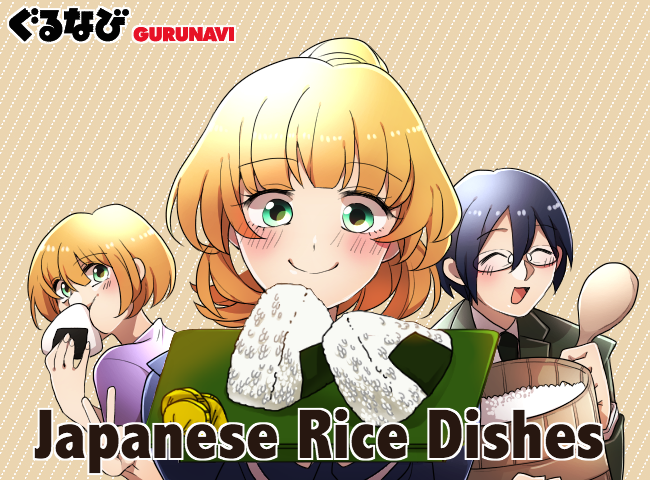

The words used to say the three daily meals in Japanese are an indicator as to just how integral rice is to the country’s cuisine and culture—breakfast translates to “morning rice” (asagohan), lunch to “lunch rice” (hirugohan) and dinner to “dinner rice” (bangohan). A traditional Japanese meal—whichever time of day—consists of “ichi ju san sai,” one soup and three side dishes, served with rice. In addition to being served on their own or as a side, rice dishes also often feature at the closing of a meal, and all together rice accounts for around a quarter of the daily caloric intake of Japan.
There are two main varieties of rice in Japan. The first is glutinous rice, known as mochigome, used mainly for making mochi, which is sticky when cooked and has a firmer, chewier texture. Uruchimai is also a short-grain variety of rice, but slightly less sticky and glutinous, and lighter in body. It’s deal for sushi, eating plain, and for use in a range of dishes, making it the most commonly used rice in Japan. Unlike with other foods, Japan is self-sufficient in rice, and for this reason among many others, is considered sacred.
Because of the integral nature of rice to Japanese culture, it’s found in many variations throughout Japanese cuisine—here is a selection of the most popular.
Explore the Delicious and Diverse Array of Rice Dishes in Japan
Takikomi Gohan
Takikomi gohan is a traditional Japanese rice dish consisting of rice, seasonings such as dashi, mirin, and soy sauce, and various ingredients like seafood, meat, and vegetables. It’s similar to Japanese mazegohan (mixed rice), but where mazegohan involves mixing cooked ingredients and seasonings into precooked rice, to prepare takikomi gohan, ingredients and seasonings are combined with uncooked rice and cooked together, integrating the flavors deeply. Takikomi gohan is a popular way to showcase seasonal ingredients, and you can find takenoko gohan (bamboo shoot rice) in spring, ayu gohan (Japanese river fish rice) in summer, kuri gohan (chestnut rice) in autumn, and kani gohan (crab rice) in winter. Other popular ingredients include chicken, konnyaku, mushrooms, carrot and gobo (burdock root). Combined, these make a classic variety called “5 ingredient rice,” known as kayaku gohan or gomoku gohan, depending on the region of Japan.
Kamameshi
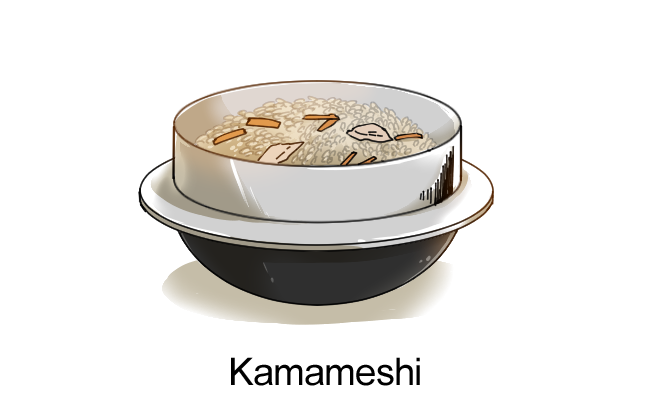
Kamameshi—“kettle rice”—is a traditional rice dish cooked in an iron pot. Its name makes reference to the vessel traditionally used to prepare it, a “kama.” This dish is similar to takikomi gohan, except for the distinguishing use of an iron pot. When cooking kamameshi, the rice is left to burn a little at the bottom, known as okoge in Japanese, which infuses the dish with a rich, toasted flavor. Kamameshi features similar varying ingredients and seasonings as takikomi gohan. To prepare it, seasonings (soy sauce and mirin) are added to uncooked rice, with other ingredients laid over top, then steamed together. Just before serving, the dish is mixed together to evenly distribute the ingredients. Originally, kamameshi was cooked in individual pots designed to serve one person. Over time, it has become popular to cook the dish in a larger pot and then eaten by family or friends dining together, either directly from the communal pot or transferred to individual bowls. Kamameshi is also a popular type of ekiben, which are bento boxes prepared especially for train travel in Japan.
Chahan

Chahan—also known as yaki-meshi, “yaki” meaning fried or grilled and “meshi” meaning rice—is Japanese fried rice. It’s believed to have come to Japan from Chinese immigrants during the 1800s, and the name is the Japanese reading of the Chinese characters used for fried rice in China. Chahan is prepared using rice that has been precooked and dried, added to a frying pan with oil and other seasonings and vegetables. Aside from the rice, there are no strict rules around what goes into chahan, including vegetables such as mushrooms and carrot, onion, garlic, tofu, pork, crab meat, prawns, and scrambled egg. It may be garnished with a little shredded shiso (Japanese basil), nori or sliced negi (green onions). Chahan is a staple food in Japanese homes, and appears on izakaya menus and in bento boxes. Premade packages of chahan flavorings are widely available in a variety of flavors at Japanese supermarkets, which can be mixed into the rice in a pan and cooked together.
Seiro-mushi

Along with frying, grilling and simmering, steaming is one of the basic techniques of Japanese cooking. Seiro-mushi falls into the steamed category, and takes its name from the bamboo basket used for steaming, known as a seiro. As well as being an extremely healthy way of preparing food, ingredients steamed slowly until they are just tender, intensify and retain their natural flavor. One notable variety is unagi seiro mushi, rice topped with eel and then steamed. Seiro-mushi are most often eaten in restaurants, and are cooked tableside in front of diners, making them a decorative feature for the dinner table.
Omurice
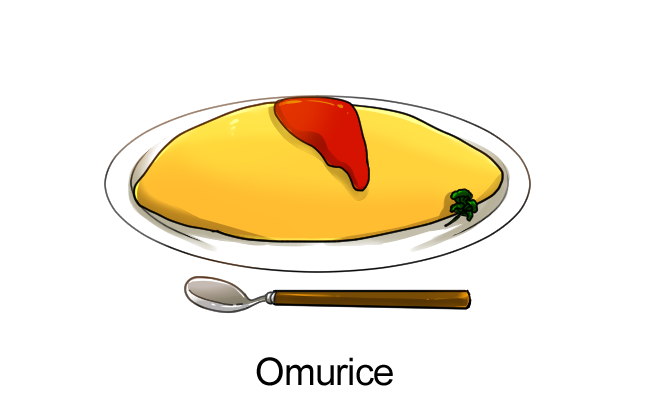
“Omu” is short for “omuretsu,” a Japanese take on the French omelette. The omurice/omuraisu comprises a thin plain egg omelette wrapped around or draped over rice cooked with tomato sauce and chicken or other ingredients, and typically comes dressed with more tomato sauce. The tomato sauce adds a sweet and savory flavor to the rice, which goes well with the creaminess of the eggs. Because of its Western-based influences, it’s part of the yoshoku (Western-style Japanese cuisine) category of food in Japan. This simple meal has been around since the early 1900s, and is eaten in cafes, Western-style diners, restaurants, and izakaya, as well as prepared in the home.
Onigiri / Omusubi
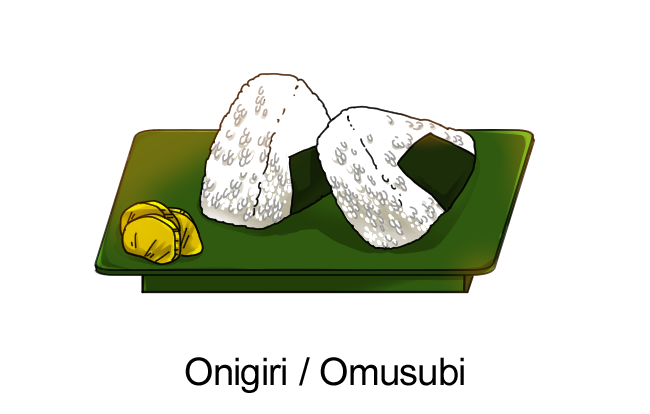
Onigiri, also called omusubi, are known as Japanese rice balls in the West, and are ubiquitous throughout Japan as both a snack and meal accompaniment. Essentially, they’re rice balls with either some kind of filling or ingredients mixed into the rice, and then shaped by hand—but there are endless variations on this simple preparation. The shape of the onigiri may be a ball, cylinder, disc or triangle. The rice may be plain, topped with a sprinkling of seasoning such as sesame seeds or yukari (red shiso powder), mixed with other ingredients such as flaked cured salmon and wakame seaweed, or filled with anything from tuna mixed with mayonnaise to spicy mentaiko, fried chicken, crumbled prawn, and ume plum. Finally, the rice ball may be served as-is, grilled, or wrapped in nori seaweed. Onigiri are eaten at any time of day, and are widely available in convenience stores, supermarkets, specialty vendors, and made in the home. They have been a beloved food for thousands of years in Japan, with the earliest record being a rice ball fossil dating back to the Yayoi period (300 B.C–A.D. 300).
Tamago Kake Gohan
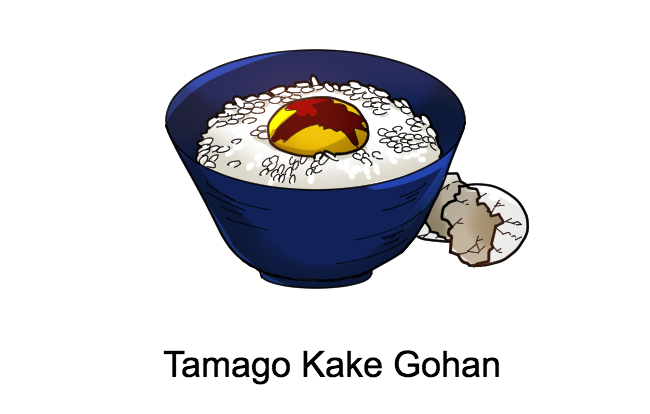
For Westerners, it may seem that a traditional Japanese breakfast is a fairly elaborate and time-consuming affair, with grilled fish, an egg dish, pickles, side dishes, rice, and miso soup. Because this is not suitable for many Japanese people living busy, modern lifestyles, there are many easy and fast Japanese-style breakfasts that have developed while still using traditional ingredients. Tamago kake gohan—also called tamago gohan or tamago bukkake meshi—is one of these. It’s a meal consisting of a bowl of hot cooked rice topped with a raw egg and seasoned with soy sauce and a pinch of salt. It’s then mixed together with chopsticks, so the egg becomes creamy and foamy and warms through. Other toppings such as furikake (a premade mixture of various seasonings), shredded nori, tsuyu (soy and dashi-based sauce) and mirin can also be added.
Sekihan
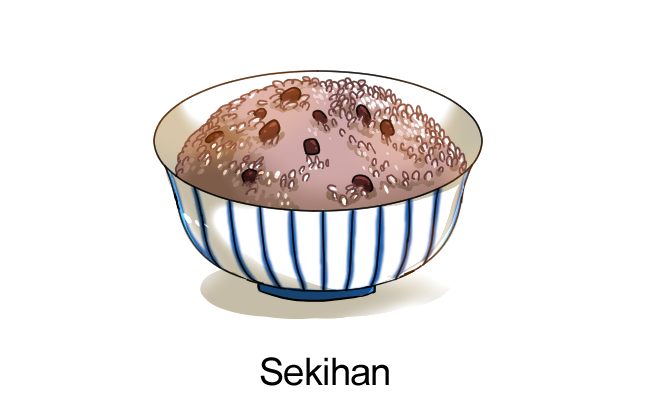
If you’re offered a reddish-colored rice dotted with beans in Japan, you’re about to eat sekihan. Sekihan has long been regarded as a special dish in Japan, served at birthdays, weddings, festivals and other celebrations, and is a key feature of Japanese New Year cuisine, osechi ryori. It’s regarded as an auspicious dish, as the red color is believed to bring good luck and ward off evil spirits. The origins of sekihan are in old Shinto rituals in Japan, when rice was an offering to the gods, and the rice of the day was naturally red. These days, sekihan is made with cooked, sweetened sticky rice (mochigome) and adzuki red beans—often regular rice added to lighten it as sticky rice is quite dense and filling. It’s served topped with kuro goma shio, a black sesame and salt mixture. Sekihan may come as a side dish alternative to a plain bowl of rice, or as onigiri, and unlike other rice side dishes, it’s also served at room temperature.
Donburi
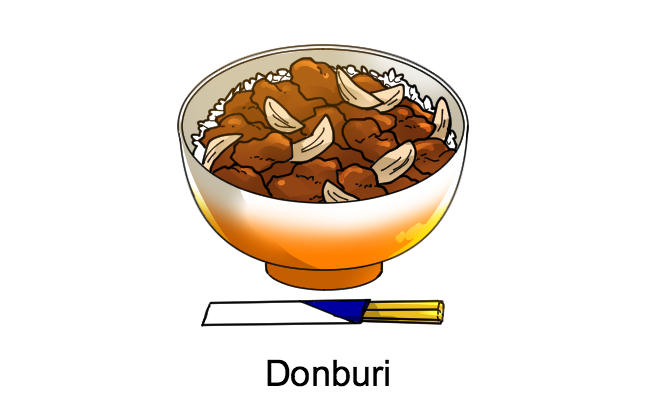
Donburi are a popular everyday food in Japan. The premise is quite simple: a bowl of steaming rice topped with an array of ingredients, but there are endless variations. Some of the popular varieties are tendon (topped with tempura), gyudon (topped with stewed beef), sakedon (topped with salmon), kaisekidon (topped with a range of raw seafood) and oyako (translated as the “mother and child” bowl, topped with chicken and egg). Donburi are sold at chain stores, family restaurants, izakaya and prepared in homes. They are often part of teishoku (Japanese set meal), accompanied by miso soup and a side dish.
Ochazuke, Okayu & Zosui
Ochazuke, okayu, and zosui are all referred to as Japanese rice porridge, gruel, or congee. They consist primarily of rice and liquid with ingredients and preparation techniques varying slightly. All are prepared at home as a quick meal, and often found at izakaya restaurants or as part of a kaiseki meal, where they're eaten as the final dish. It’s common to eat these dishes when ill or after consuming alcohol to replenish the body.

“Ocha” means tea in Japanese, and “zuke” means to submerge, together, they refer to a meal of rice submerged in hot tea. To make ochazuke, cooked rice is added to a small bowl, then topped with desired ingredients, and covered with freshly brewed green tea or dashi. Toppings include a range of seaweeds, fresh or cooked fish, arare rice crackers, sesame seeds, and furikake.
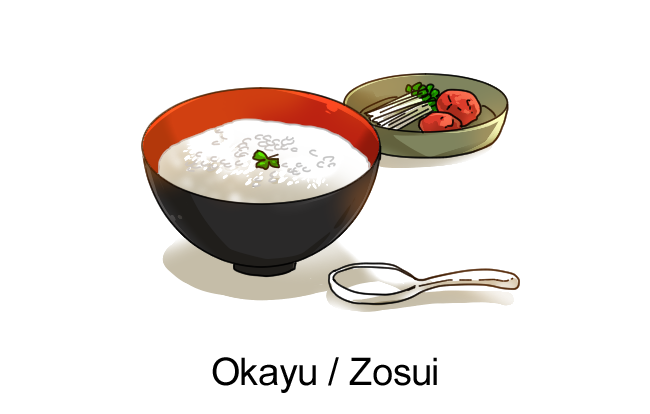
Okayu and zosui are both dishes of rice cooked with plenty of liquid until becoming soft, thick and soupy. Okayu is made from uncooked rice cooked in water and served with ume plum, tsukemono, herbs, or other toppings. Zosui refers to rice cooked with dashi and other ingredients, or pre-cooked rice added to the broth in a hot pot as it nears the end, and an egg often added as well.
Sushi
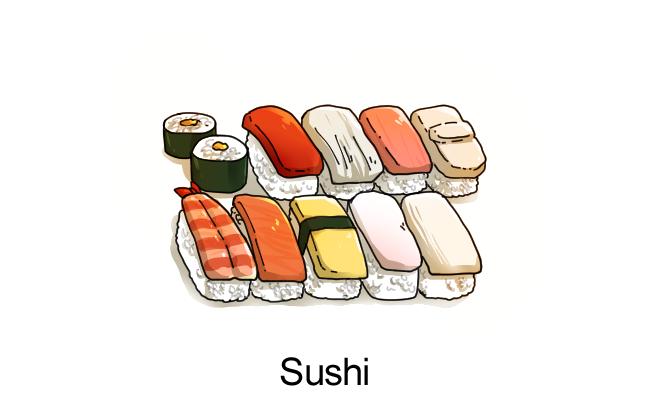
No list about Japanese rice dishes is complete without mentioning sushi. An archetypal Japanese food, sushi is as popular within Japan as it is perceived. Whether this is at high-end sushiya, a kaitenzushi, in bento, or prepared in the home—it's beloved by people of all ages. Essentially, sushi is vinegared rice, known as shari or sumeshi, served with raw seafood; but it may also be served with egg, tofu, vegetables, or meat, and may also be served with the neta (topping) aburi-style (blow-torched) rather than raw. Sushi comes in many different forms, with the main ones being traditional Kansai-style oshizushi (pressed sushi), Kanto-style nigiri, makizushi (rolled sushi), temaki (hand-rolled sushi shaped in a cone), and gunkanmaki (“battleship sushi” with a strip of nori wrapped around a ball of rice and filled with a topping).
A Meal, a Snack, a Side Dish - Japanese Rice Dishes Cover All Bases
Rice in Japan is essential to national identity and daily life. Aside from the bowls of plain rice inherent to every meal, there are many traditional and modern ways to prepare rice. Many of these can be tailored to suit personal tastes and dietary needs. With so many nourishing and delicious ways to eat rice in Japan, why not browse Gurunavi’s listings to discover where you can try one of these many rice dishes yourself.










